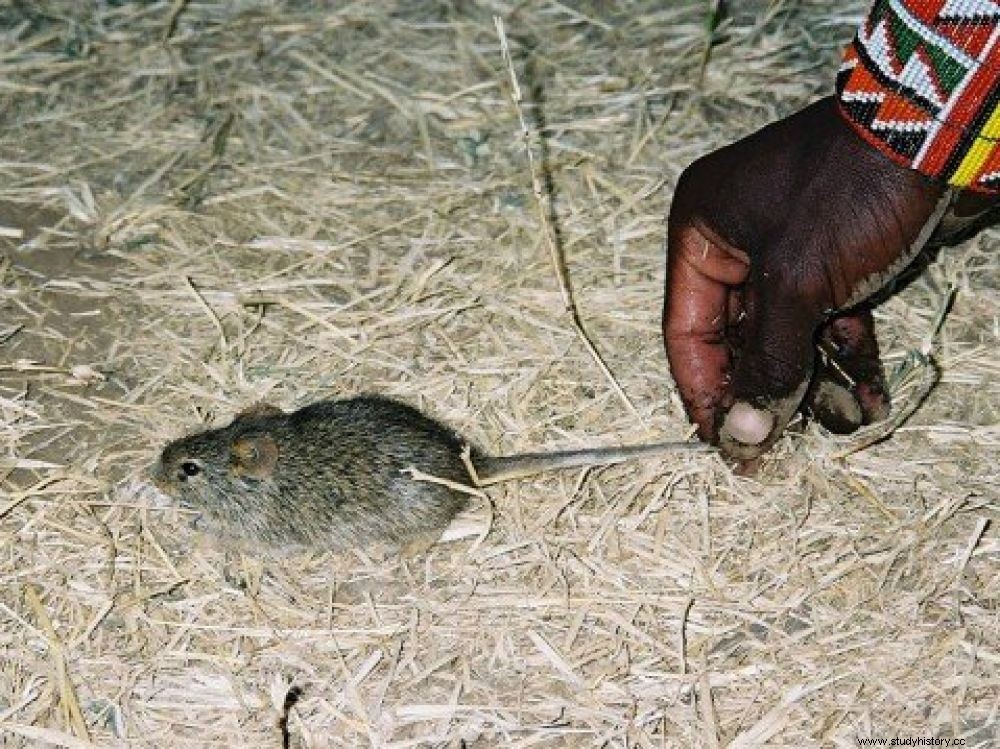An international team dates back 15,000 years the arrival of the mouse in the homes of men. The emergence of this biological relationship called "commensalism" therefore began long before the invention of agriculture and demonstrates that human activity modified ecosystems very early on.

A long-tailed spiny mouse captured in a Maasai village in southern Kenya.
SEDENTARY. 15,000 years ago, people of the Natufian culture roamed the hills of the West Bank. These hunter-gatherers lived there from the consumption of wild cereals and from hunting. It was at this pivotal time that the first villages of small circular houses were created, the foundations of which archaeologists have been excavating for decades. This beginning of sedentarization will lead more than 5000 years later to agriculture.
However, we find on these sites mouse teeth. “We then wondered if the arrival of the mouse in the close environment of man dated from agriculture, which required storing large and very attractive quantities of seeds to eat and sow, or if it dated back to those first settlements explains Thomas Cucchi, researcher at the Archaeozoology and Archaeobotany laboratory (CNRS/National Museum of Natural History). After an investigation carried out by French, Israeli and American researchers, and even requiring a trip to the Maasai tribes of Africa, the answer has just been provided in the PNAS. The mouse did not wait for agriculture to invite itself to the men's table.
The same proportion of domestic and wild mice in the Neolithic period and today
TEETH. First step, Thomas Cucchi went to collect the paleontological and archaeological remains of mice stored at the Hebrew University of Jerusalem. “There are nearly 400 tooth fossils dating from 200,000 to 10,000 years old from numerous excavation campaigns collected to highlight the appearance of the commensal mouse “, he continues. The researcher then photographs these one-millimeter teeth to analyze their shape in geometric morphometry and distinguish the two twin species of mice potentially present:Mus musculus domesticus , the mouse of our homes and cities and its wild counterpart in this region, the short-tailed mouse Mus macedonicus . For millennia, the two species lived side by side. But thanks to the examination of the teeth, the researcher was able to prove that the mouse of the cities completely excluded the mouse of the fields in the first villages of the men. “Mus musculus domesticus has taken advantage of the opportunities of this new man-made environment where food is abundant and predators and competitors are excluded “says Thomas Cucchi. It is the mouse who decides on this natural relationship while remaining wild. A winning strategy:the rodent is present in all climates and is one of the most invasive mammals on the planet.
Between 15,000 and 13,000 years ago, the Natufian culture experienced periods of partial return to nomadism. The villages have lost in density. And the wild mouse has returned to mingle with its domestic cousin while remaining a minority. "Competition between the commensal mouse and wild species has fluctuated depending on whether humans return to movement during dry periods or return to sedentary life at other times, indicating the strong influence of the environment on the mobility of people and the complexity of the relationships they maintain with their neighborhood », Explains Lior Weissbrod, researcher at the Institute of Archeology of the University of Haifa (Israel) in Science daily . However, Mus domesticus always remained close to men. It is therefore necessary to trace the origin of this commensalism to this period of sedentarization.
MASAI. To find out for sure, Lior Weissbrod went to check with semi-nomadic Maasai herders in Kenya if we found the same relationship with rodents. He was able to observe in these nomads a similar competition between two species of rodents of the genus Acomys . As close as possible to the habitats, the researcher took 80% of spiny mice with long tails against only 20% of the neighboring species with short tails, i.e. proportions identical to those recorded on the Natufian sites occasionally occupied. “This result demonstrates the age of the impact of man on his environment , concludes Thomas Cucchi.As soon as men became sedentary and maintained long-term pressure on the same environment, they changed the balance of ecosystems .
